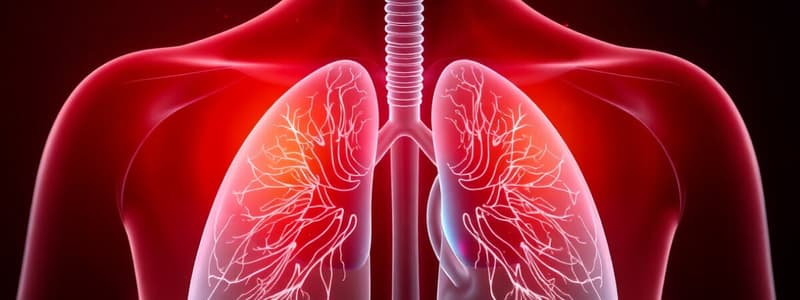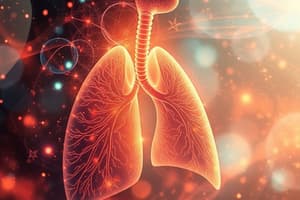Podcast
Questions and Answers
Which of the following best describes the underlying cause of airflow obstruction in asthma?
Which of the following best describes the underlying cause of airflow obstruction in asthma?
- Decreased mucus production.
- Reduced airway hyperresponsiveness.
- Dilation of bronchial smooth muscle.
- Bronchoconstriction and inflammation. (correct)
A patient with mild, intermittent asthma requires a quick-relief medication. Which of the following would be most appropriate?
A patient with mild, intermittent asthma requires a quick-relief medication. Which of the following would be most appropriate?
- Inhaled corticosteroid (ICS)
- Leukotriene modifier
- Long-acting beta-2 agonist (LABA)
- Short-acting beta-2 agonist (SABA) (correct)
Which of the following best describes the mechanism of action of corticosteroids in treating asthma?
Which of the following best describes the mechanism of action of corticosteroids in treating asthma?
- They block the action of leukotrienes.
- They directly relax bronchial smooth muscle.
- They inhibit mast cell degranulation.
- They inhibit phospholipase A2, reducing the release of arachidonic acid and decreasing inflammation. (correct)
A patient with moderate persistent asthma is prescribed a long-acting beta-2 agonist (LABA). Which of the following is the most appropriate way to administer this medication?
A patient with moderate persistent asthma is prescribed a long-acting beta-2 agonist (LABA). Which of the following is the most appropriate way to administer this medication?
Which of the following is a potential adverse effect associated with inhaled corticosteroids (ICS)?
Which of the following is a potential adverse effect associated with inhaled corticosteroids (ICS)?
How do leukotriene modifiers work to treat asthma?
How do leukotriene modifiers work to treat asthma?
A patient is prescribed cromolyn for mild persistent asthma. What is the mechanism of action of this medication?
A patient is prescribed cromolyn for mild persistent asthma. What is the mechanism of action of this medication?
Which of the following is a characteristic of COPD that differentiates it from asthma?
Which of the following is a characteristic of COPD that differentiates it from asthma?
According to COPD treatment guidelines, what is the preferred first-line treatment for a patient with COPD experiencing fewer symptoms and at low risk?
According to COPD treatment guidelines, what is the preferred first-line treatment for a patient with COPD experiencing fewer symptoms and at low risk?
In COPD management, when are inhaled corticosteroids (ICS) recommended?
In COPD management, when are inhaled corticosteroids (ICS) recommended?
Which of the following is the most important step in using a metered-dose inhaler (MDI) correctly?
Which of the following is the most important step in using a metered-dose inhaler (MDI) correctly?
What is the primary purpose of using a spacer with a metered-dose inhaler (MDI)?
What is the primary purpose of using a spacer with a metered-dose inhaler (MDI)?
Which of the following is the main cause of allergic rhinitis symptoms?
Which of the following is the main cause of allergic rhinitis symptoms?
Which of the following best describes the action of antihistamines in treating allergic rhinitis?
Which of the following best describes the action of antihistamines in treating allergic rhinitis?
Why are second-generation antihistamines generally preferred over first-generation antihistamines for treating allergic rhinitis?
Why are second-generation antihistamines generally preferred over first-generation antihistamines for treating allergic rhinitis?
What is the most effective way to treat allergic rhinitis?
What is the most effective way to treat allergic rhinitis?
How do decongestants work to relieve symptoms of allergic rhinitis?
How do decongestants work to relieve symptoms of allergic rhinitis?
Why is it generally recommended to limit the use of intranasal decongestants to a maximum of 3 days?
Why is it generally recommended to limit the use of intranasal decongestants to a maximum of 3 days?
When is it appropriate to inhibit a cough?
When is it appropriate to inhibit a cough?
What is a key counseling point for a patient prescribed benzonatate for cough?
What is a key counseling point for a patient prescribed benzonatate for cough?
Which class of medications decreases the sensitivity of cough centers in the CNS?
Which class of medications decreases the sensitivity of cough centers in the CNS?
Which of the following is an example of a long-acting muscarinic antagonist (LAMA) used in COPD?
Which of the following is an example of a long-acting muscarinic antagonist (LAMA) used in COPD?
A patient with severe persistent asthma is poorly controlled on conventional therapy. Which of the following medications might be considered?
A patient with severe persistent asthma is poorly controlled on conventional therapy. Which of the following medications might be considered?
A DPI (dry powder inhaler) requires what from the patient for proper use?
A DPI (dry powder inhaler) requires what from the patient for proper use?
Flashcards
Asthma
Asthma
Chronic disease with hyperreactive airways leading to episodic obstruction.
COPD
COPD
Chronic and progressive airflow obstruction that can be fatal.
Triggers
Triggers
The main trigger for asthma attacks.
Asthma therapy goals
Asthma therapy goals
Signup and view all the flashcards
Quick relief for asthma
Quick relief for asthma
Signup and view all the flashcards
Examples of SABAs
Examples of SABAs
Signup and view all the flashcards
Examples of LABAs
Examples of LABAs
Signup and view all the flashcards
Corticosteroids
Corticosteroids
Signup and view all the flashcards
Inhaled Corticosteroids
Inhaled Corticosteroids
Signup and view all the flashcards
Leukotriene Modifiers
Leukotriene Modifiers
Signup and view all the flashcards
Examples of Leukotriene Modifiers
Examples of Leukotriene Modifiers
Signup and view all the flashcards
Cromolyn
Cromolyn
Signup and view all the flashcards
COPD
COPD
Signup and view all the flashcards
Long Acting Bronchodilators
Long Acting Bronchodilators
Signup and view all the flashcards
COPD Medication
COPD Medication
Signup and view all the flashcards
Important ADE consideration
Important ADE consideration
Signup and view all the flashcards
Inhaled route benefits
Inhaled route benefits
Signup and view all the flashcards
Spacers
Spacers
Signup and view all the flashcards
Allergic Rhinitis
Allergic Rhinitis
Signup and view all the flashcards
Block H1 receptors
Block H1 receptors
Signup and view all the flashcards
Antihistamine preferences
Antihistamine preferences
Signup and view all the flashcards
Intranasal Corticosterioids
Intranasal Corticosterioids
Signup and view all the flashcards
Decongestants
Decongestants
Signup and view all the flashcards
Cough w/ Infection
Cough w/ Infection
Signup and view all the flashcards
Dextromethorphan
Dextromethorphan
Signup and view all the flashcards
Study Notes
Respiratory Disorders
- Asthma is a chronic condition involving hyperreactive airways that lead to episodic obstruction
- Asthma is often underdiagnosed and undertreated
- COPD (Chronic Obstructive Pulmonary Disease) is a chronic and progressive airflow obstruction, and is eventually fatal
- Allergic Rhinitis is a chronic condition characterized by red, itchy, watery eyes, a runny nose, and a non-productive cough
Pathophysiology of Asthma
- Asthma involves airflow obstruction due to bronchoconstriction
- Contraction of bronchial smooth muscle and inflammation of the bronchial wall contributes to asthma
- Increased mucus production is a part of asthma pathophysiology
- Underlying inflammation leads to airway hyperresponsiveness and airflow limitation
- Respiratory symptoms are a consequence of these factors
- Asthma is a chronic condition
- Triggers can stimulate asthma attacks
Drugs Used to Treat Asthma - Goals of Therapy
- Reverse and prevent airway inflammation
- Decrease the frequency and intensity of asthma symptoms
- Prevent exacerbations
- Minimize limitations in activity for asthma patients
Drugs Used to Treat Asthma - Beta Agonists (Quick Relief)
- Short Acting Beta-2 Agonists are used for quick relief
- Onset of action: 5-30 minutes, Duration: 4-6 hours
- Used for symptomatic treatment of bronchospasm
- Monotherapy is used for mild or intermittent asthma, or exercise-induced bronchospasm
- Can be used as an adjunct in moderate persistent and severe persistent cases
- Adverse effects (ADEs) are limited with direct inhalation delivery
- Examples include Albuterol & Levalbuterol
Drugs Used to Treat Asthma - Beta Agonists (Long-Term Control)
- Long Acting Beta-2 Agonists are used for long-term control
- They offer prolonged bronchodilation for at least 12 hours
- Used as an adjunct to Inhaled Corticosteroids (ICS) in moderate and severe asthma
- Monotherapy using LABAs is contraindicated in asthma
- Examples include Salmeterol and Formoterol
Drugs Used to Treat Asthma - Corticosteroids
- Corticosteroids are the Drug of Choice (DOC) for long-term control of persistent asthma
- Mechanism of Action (MOA): inhibit phospholipase A2 to decrease the release of arachidonic acid
- Decreases inflammatory cascade
- Reduced hyperresponsiveness of airway smooth muscle
- Examples include Beclomethasone, Budesonide, Fluticasone, and Mometasone
Drugs Used to Treat Asthma - Corticosteroids Routes
- Inhalation reduces systemic ADEs
- Inhalation includes Beclomethasone, Budesonide, Fluticasone, Mometasone
- Inhalation technique is important
- Oral/systemic corticosteroids (Prednisone, Methylprednisolone) are used in severe exacerbations
Drugs Used to Treat Asthma - Corticosteroids ADEs
- With Inhaled Corticosteroids (ICS): Oropharyngeal candidiasis and hoarseness
- Systemic ADEs: Osteoporosis, hyperglycemia, hypokalemia, hypertension, peripheral edema, immunosuppression, increased appetite
Drugs Used to Treat Asthma - Leukotriene Modifiers
- Examples include Zileuton, Zafirlukast, and Montelukast
- They inhibit the production (Zileuton) or action (Zafirlukast, Montelukast) of Leukotrienes
- Result: Decreased inflammation, arteriolar constriction, and mucus production
- Use: Generally 2nd line
- Prevention of asthma symptoms
- Prevention of exercise-induced asthma
- ADEs: Increased liver enzymes, headache, and dyspepsia
Drugs Used to Treat Asthma - Cromolyn
- Cromolyn inhibits mast cell degranulation and histamine release
- Alternative for Mild Persistent Asthma
- Short Duration Of Action (DOA) limits use
Drugs Used to Treat Asthma - Cholinergic Antagonists
- Cholinergic Antagonists inhibit vagal effects on the airways
- Short Acting (Ipratropium) has a slower onset than Short Acting Beta Agonists (SABA)
- Used in Asthma-COPD Overlap Syndrome, with SABA in ER, and when SABA is not tolerated
- Long Acting (Tiotropium) is an Add-on in adults with severe asthma with a history of exacerbations
- ADEs: Xerostomia, bitter taste
Drugs Used to Treat Asthma - Theophylline
- Theophylline is a bronchodilator for chronic asthma
- Replaced by beta-2 agonists and ICS: Narrow Therapeutic Index (TI), requires drug level monitoring, poor ADE profile, numerous drug interactions
Drugs Used to Treat Asthma - Monoclonal Antibodies
- Used in severe persistent asthma poorly controlled on conventional therapy
- Omalizumab: Binds to and inhibits IgE
- Mepolizumab, Benralizumab, Reslizumab: Interleukin-5 antagonists
- Use is limited by cost, route of administration, and adverse effects (ADEs)
Pathophysiology of COPD
- COPD is chronic, irreversible obstruction of airflow
- It is a progressive disease characterized by persistent symptoms
- Treatment involves smoking cessation
- Pharmacologic therapy to relieve symptoms and slow progression, addressing cough, excess mucus production, chest tightness, breathlessness, difficulty sleeping, and fatigue
Drugs Used to Treat COPD - Bronchodilators
- Long Acting Bronchodilators are preferred first-line treatment for COPD
- LABA: Indacaterol, Olodaterol, Vilanterol (once daily) & Aformoterol, Formoterol, Salmeterol (twice daily)
- LAMA: Aclidinium, Tiotropium, Glycopyrrolate, Umeclidinium
- Short-acting bronchodilators okay for patients at low risk with fewer symptoms
- A combination of LABA and LAMA is recommended in high-risk patients with more symptoms
- May be used if an inadequate response to one agent alone
Drugs Used to Treat COPD - Corticosteroids
- ICS is only recommended in select situations
- Can be added to a long-acting bronchodilator if FEV1 < 60% predicted
- Can only be added to a long-acting bronchodilator if symptoms of both asthma and COPD
- Oral corticosteroids are only for acute exacerbations
Inhaler Technique
- Inhaler technique is critical and should be assessed regularly
- Metered Dose Inhaler (MDI): Have propellants that eject the medication from the canister
- Exhale first
- Begin to inhale as you press the canister
- Continue inhaling throughout actuation
- Dry Powder Inhaler (DPI) requires a puncture capsule
- Inhale quickly and deeply to deposit the drug in the lungs
- Rinse mouth after any inhaled steroid
- Spacers involve a large canister that attaches to an MDI
- Allows large drug particles to "drop out" in the canister; only smaller, aerosolized particles make it to the lungs
- Minimizes the amount of drug deposited in the mouth and pharynx
- Simplifies technique
- Masks can be attached to a spacer to allow for easy delivery to young children
Pathophysiology of Allergic Rhinitis
- Inflammation of the mucous membranes of the nose is typically caused by inhalation of an allergen
- Common allergens: Dust, Pollen, Animal dander
- The allergen interacts with mast cells coated with IgE, causing the release of pro-inflammatory mediators
- Including Histamine and Leukotrienes
- Symptoms: Sneezing, itchy nose and eyes, watery rhinorrhea, nasal congestion, non-productive cough
Drugs Used to Treat Allergic Rhinitis
- Antihistamines block H1 receptors to manage symptoms caused by histamine release
- rapid onset of action to treat symptoms
- most effective at preventing symptoms of mild or intermittent disease
- First-generation antihistamines cause sedation & anticholinergic ADEs
- Second-generation agents are preferred
- Delivery can be oral, intranasal, or ophthalmic
Drugs Used to Treat Allergic Rhinitis - Intranasal Corticosteroids
- Are the most effective agents for Allergic Rhinitis (AR)
- Symptom improvement occurs 3-36 hours after the first dose
- Targets sneezing, itching, rhinorrhea, and congestion
- ADEs are localized
- Avoid deep breathing while administering
- Examples include Beclomethasone, Budesonide, Fluticasone, Mometasone, and Triamcinolone
Drugs Used to Treat Allergic Rhinitis - Decongestants
- Alpha Agonists cause arteriole constriction in the nasal mucosa
- Intranasal: Phenylephrine, Oxymetazoline
- rapid onset of action
- limited to 3 days of use
- Oral: Pseudoephedrine
- longer duration of action
- increased systemic side effects
- is not recommended for long-term treatment of allergic rhinitis
Cough
- Cough due to an underlying infection should not be inhibited if possible
- Before treating a cough, identify its cause and treat the cause when possible
- Opioids include Codeine:
- decreases sensitivity of cough centers in the Central Nervous System (CNS)
- with addictive potential and poor ADE profile
- Dextromethorphan is a synthetic derivative of morphine with the same antitussive effects but a better ADE profile
- Benzonatate suppresses the cough reflex peripherally
- Do not break capsules
- ADEs include dizziness and numbness of tongue/mouth/throat
Studying That Suits You
Use AI to generate personalized quizzes and flashcards to suit your learning preferences.




